Trees Birds Mammals Fish Amphibians Reptiles
Wild Algarve
Bookshop
Hortiboletus rubellus Krombh. - Ruby Bolete
Phylum: Basidiomycota - Class: Agaricomycetes - Order: Boletales - Family: Boletaceae
Distribution - Taxonomic History- Etymology - Identification - Culinary Notes - Reference Sources
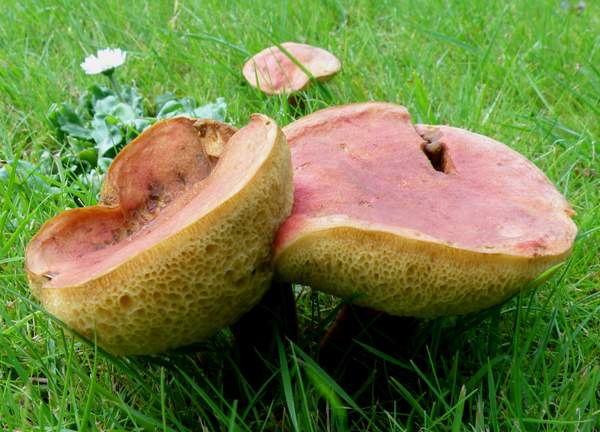
Hortiboletus rubellus, the Ruby
Bolete, is a very pretty little mushroom, and usually it fruits in groups or rows rather than singly. It is frequently found on woodland edges, in clearings and in low-neutrient grassland in parks and gardens beneath deciduous trees, particularly oaks.
Distribution
Occasional in southern Britain but rare or absent in the north, Hortiboletus rubellus usually appears in groups of typically 3 to 10.
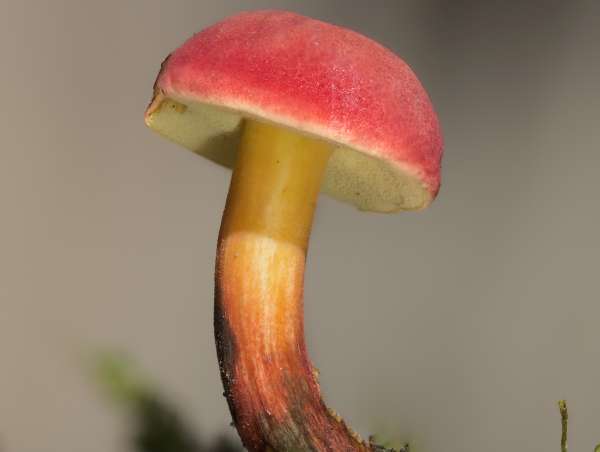
Taxonomic history
Given the name Boletus rubellus in 1836 by Czech mycologist Julius Vincenz von Krombholz (1782 - 1843), this lovely bolete was transferred to the new genus Hortiboletus in 2015 by Italian mycologists Giampaolo Simonini, Alfredo Vizzini, and Matteo Gelard on the basis of recent molecular (DNA) studies that indicated the need for a major revision of the Boletaceae. This resulted in the current scientific name Hortiboletus rubellus (Krombh.) Simonini, Vizzini & Gelardi,
Synonyms of Hortiboletus rubellus include Boletus rubellus Krombh, Xerocomellus rubellus (Krombh.) Šutara, Boletus sanguineus With., Boletus versicolor Rostk., Xerocomus rubellus (Krombh.) Quél., and Xerocomus versicolor (Rostk.) E.-J. Gilbert.
Hortiboletus rubellus is the type species of the new genus Hortiboletus.
Etymology
The old generic name Boletus comes from the Greek bolos, meaning 'lump of clay', while in the new genus name the prefix Horti- comes from the Latin noun Hortus, meaning 'garden'; this is a reference to one of the main habitats in which this bolete is commonly found. The specific epithet rubellus is also Latin and means 'reddish'.
Identification guide
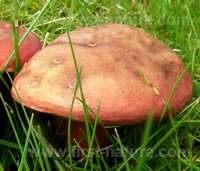 |
Cap
Ruby Bolete caps range from 3 to 8cm across, broadly convex and then flattening, occasionally with a slight central depression; scarlet red at first, fading to an olivaceous red at maturity and usually with a yellowish marginal band; surface dry and velvety, rarely cracking even when old. The cap cuticle is a palisadoderm of heavily incrusted hyphae. |
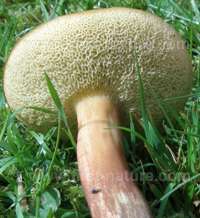 |
Tubes and Pores
The tubes are dull yellow and terminate in lemon-yellow pores that become greenish with age.
When bruised, the pores and tubes slowly turn blue.
|
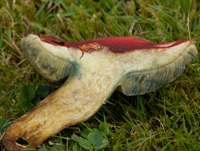 |
Stem
Stems of Hortiboletus rubellus are 4 to 8cm long and 4 to 8mm in diameter, cylindrical; bright yellow at the apex, and progressively more red towards the base.
The stem flesh is pale yellow, becoming a deeper yellow low down near the base and turns blue when cut. |
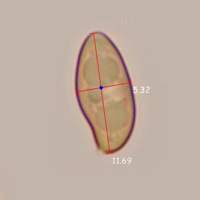 |
Spores
Subfusiform to subellipsoidal, smooth; 11.5-12.5 x 5-5.5µm.
Show larger image
Spore print
Olive-brown. |
Odour/taste |
Faint pleasant smell; no significant taste (although some find it slightly soapy). |
Habitat & Ecological role |
Hortioletus rubellus is an ectomycorrhizal fungus; it is found growing on rich soil beneath trees, notably beech and
oak - frequently in parks and gardens. |
Season |
Early July to the end of September in Britain and Ireland. |
Similar species |
Worldwide, this is one of a complex of similar species that can be separated only by microscopic analysis (and even then determination can be far from certain). In Britain and on mainland Europe it is most similar to Hortiboletus engelii (which has a much browner cap even when young and fresh) but could also be confused with Rheubarbariboletus armeniacus, a rare species that has a similar reddish cap but lacks the red colouring on the stem. |
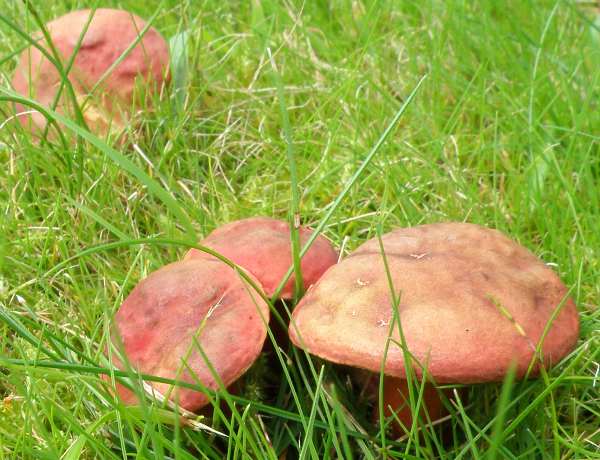
Culinary Notes
Although some authorities state that they are edible but with a soapy flavour - hardly a recommendation - these little mushrooms are prone to maggot infestation.
Those are just two good reasons for not gathering Hortiboletus rubellus, and if anyone needs a third then they are quite a rare find in Britain and so the beautiful fruitbodies are surely best left for others to enjoy.
Reference Sources
Fascinated by Fungi, 2nd Edition, Pat O'Reilly 2016, reprinted by Coch-y-bonddu Books in 2022.
British Boletes, with keys to species, Geoffrey Kibby (self published) 3rd Edition 2012
BMS List of English Names for Fungi
Roy Watling & Hills, A.E. 2005. Boletes and their allies (revised and enlarged edition), - in: Henderson, D.M., Orton, P.D. & Watling, R. [eds]. British Fungus Flora. Agarics and boleti. Vol. 1. Royal Botanic Garden, Edinburgh.
Dictionary of the Fungi; Paul M. Kirk, Paul F. Cannon, David W. Minter and J. A. Stalpers; CABI, 2008
Taxonomic history and synonym information on these pages is drawn from many sources but in particular from the British Mycological Society's GB Checklist of Fungi.
Acknowledgements
This page includes pictures kindly contributed by David Kelly and Joanna McManus.
Top of page...
Fascinated by Fungi. Back by popular demand, Pat O'Reilly's best-selling 450-page hardback book is available now. The latest second edition was republished with a sparkling new cover design in September 2022 by Coch-y-Bonddu Books. Full details and copies are available from the publisher's online bookshop...